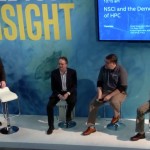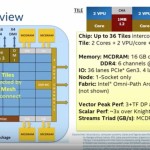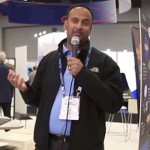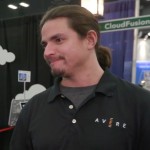“We expect NCSI to run for the next two decades. It’s a bit audacious to start a 20 year project in the last 18 months of an administration, but one of the things that gives us momentum is that we are not starting from a clean sheet of paper. There are many government agencies already involved and what we’re really doing is increasing their coordination and collaboration. Also we will be working very hard over the next 18 months to build momentum and establish new working relationships with academia and industry.”
Video: Storage Architecture for Innovation & Research at the University of Florida
In this video from the DDN booth at SC15, Dr. Erik Deumens of the University of Florida describes why unpredictable and less standard architectures and system configurations are necessary to meet the agility, availability and responsiveness requirements to meet the mission of innovation and exploration. “The University of Florida’s Interdisciplinary Center for Biotechnology Research (ICBR) offers access to cutting-edge technologies designed to enable university faculty, staff and students, as well as research and commercial partners worldwide with the tools and resources needed to advance scientific research.”
Alan Alda to Receive Public Welfare Medal from National Academy of Sciences
The National Academy of Sciences is presenting its 2016 Public Welfare Medal to actor, director, writer, and science communicator Alan Alda in recognition of his “extraordinary application of the skills honed as an actor to communicating science on television and stage, and by teaching scientists innovative techniques that allow them to tell their stories to the public.” Alda, who was the keynote speaker at SC15, will receive the award on May 1 during the Academy’s 153nd annual meeting.
Video: MCDRAM (High Bandwidth Memory) on Knights Landing
“The Intel’s next generation Xeon Phi processor family x200 product (code-name Knights Landing) brings in new memory technology, a high bandwidth on package memory called Multi-Channel DRAM (MCDRAM) in addition to the traditional DDR4. MCDRAM is a high bandwidth (~4x more than DDR4), low capacity (up to 16GB) memory, packaged with the Knights Landing Silicon. MCDRAM can be configured as a third level cache (memory side cache) or as a distinct NUMA node (allocatable memory) or somewhere in between. With the different memory modes by which the system can be booted, it becomes very challenging from a software perspective to understand the best mode suitable for an application.”
The Death and Life of Traditional HPC
The consensus of the panel was that making full use of Intel SSF requires system thinking at the highest level. This entails deep collaboration with the company’s application end-user customers as well as with its OEM partners, who have to design, build and support these systems at the customer site. Mark Seager commented: “For the high-end we’re going after density and (solving) the power problem to create very dense solutions that, in many cases, are water-cooled going forward. We are also asking how can we do a less dense design where cost is more of a driver.” In the latter case, lower end solutions can relinquish some scalability features while still retaining application efficiency.
Video: Microsoft Azure for Engineering Analysis and Simulation
Tejas Karmarkar from Microsoft presented this talk at SC15. “Azure provides on-demand compute resources that enable you to run large parallel and batch compute jobs in the cloud. Extend your on-premises HPC cluster to the cloud when you need more capacity, or run work entirely in Azure. Scale easily and take advantage of advanced networking features such as RDMA to run true HPC applications using MPI to get the results you want, when you need them.”
Video: A Brief Introduction to OpenFabrics
Sean Hefty from Intel presented this talk at the Intel HPC Developer Conference at SC15. “OpenFabrics Interfaces (OFI) is a framework focused on exporting fabric communication services to applications. OFI is best described as a collection of libraries and applications used to export fabric services. The key components of OFI are: application interfaces, provider libraries, kernel services, daemons, and test applications. Libfabric is a core component of OFI. It is the library that defines and exports the user-space API of OFI, and is typically the only software that applications deal with directly. It works in conjunction with provider libraries, which are often integrated directly into libfabric.”
Video: Intel Black Belt Discussion on HPC Code Modernization
In this video from the Intel HPC Developer Conference at SC15, James Reinders hosts an Intel Black Belt discussion on Code Modernization. “Modern high performance computers are built with a combination of resources including: multi-core processors, many core processors, large caches, high speed memory, high bandwidth inter-processor communications fabric, and high speed I/O capabilities. High performance software needs to be designed to take full advantage of these wealth of resources. Whether re-architecting and/or tuning existing applications for maximum performance or architecting new applications for existing or future machines, it is critical to be aware of the interplay between programming models and the efficient use of these resources. Consider this a starting point for information regarding Code Modernization. When it comes to performance, your code matters!”
Video: Overcoming Storage Roadblocks in HPC Clouds
“The virtually infinite scale of cloud compute resources is now within easy reach from either existing network-attached or object-based storage. No longer is the location of your storage a roadblock to reaping the ease, timeliness, and cost offered by cloud compute services. Avere’s Enterprise Cloud Bursting solution utilizes the Virtual FXT Edge filer (vFXT) which puts high-performance, scalable NAS where you need it to enable massive compute on-demand for enterprise apps with simple installation and zero hardware maintenance. Avere makes your NAS data accessible to cloud compute without experiencing latency or requiring that your data be moved to the cloud.”
Video: Intersect360 Research Describes HPC Market Trends at SC15
In this video from the Dell booth at SC15, Addison Snell from Intersect360 Research discusses why HPC is now important to a broader group of use cases, and dug deep into overviews of HPC for research, life sciences and manufacturing. Participants learned more about why HPC, Big Data, and Cloud are converging.












